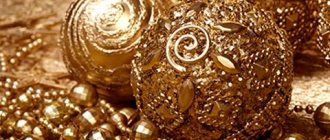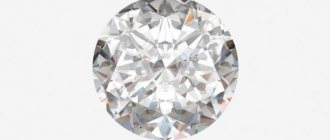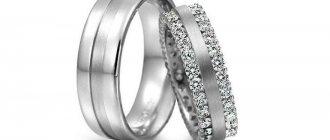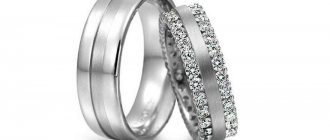The tradition of decorating oneself with jewelry goes back to ancient times. Archaeologists find confirmation of this during excavations in different parts of the world. At different times, both men and women decorated themselves, their suits and shoes.
Jewelry making has become a profession, jewelry has become a work of art. The number of jewelry that a woman decorates herself with at a time depends on the cultural traditions in which she grew up and was brought up, and on the level of material wealth. In Soviet times, we were taught from the pages of women's magazines that it was considered good form to wear a maximum of one gold ring on your hands. Most often it was a wedding ring. And among women of the Arab East it was customary to wear all the gold jewelry they had. Her husband could tell her in front of witnesses that he was divorcing her, and she would leave his house in what she was wearing. But even if we have only one gold ring and one pair of gold earrings or one gold chain, and everything else is jewelry, we want them to always please the eye. And although jewelry is resistant to environmental influences, it requires care. Therefore, I will share those useful tips for caring for jewelry that I purchased along with jewelry.
Useful tips
- First of all, in order to protect jewelry from contamination and damage, they should be removed during housework, as well as when using cosmetics: whitening creams, soap, perfume, acetone.
- It is better to store all jewelry in a closed box or casket (which themselves can be a decoration for the dressing table) away from heating devices and direct sunlight. Under the influence of ultraviolet rays, amethysts, colored topaz (except golden), pearls and turquoise, as well as rubies and garnets lose their color intensity. A ruby can completely lose its color when exposed to extreme heat.
- All jewelry with stone inserts are “afraid” of sudden temperature changes and high humidity. Therefore, the bathroom is the worst place to store jewelry, especially silver.
Prevention
You can preserve your jewelry's original appearance even without thorough cleaning. To do this, you should develop several useful habits:
- Remove the gold daily and wipe it with a microfiber cloth. This will remove surface dirt and dust that has accumulated during the day. If you don’t have a microfiber cloth, a suede or flannel cloth will do.
- Areas with stones should be cleaned with special care, as this is where dust accumulates. In addition to surface cleaning, periodically wipe the area with a cotton swab soaked in glycerin.
- Various cosmetics also have a bad effect on the condition of the aurum. Therefore, it is recommended to remove rings when applying cream to your hands, and also make sure that perfume does not splash on your jewelry.
- You should not do household chores wearing rings and bracelets to avoid water and chemicals getting on the metal.
- Remove all jewelry before playing sports. This will protect them from breakage, scratches and loss.
- Don't forget to take off your jewelry when taking a bath or shower, or swimming in the pool or sea.
- Jewelry should be stored in a box lined with soft fabric inside. Place them separately from each other so that they do not touch each other.
By following all these simple rules, you will not only maintain the presentable appearance of your products, but also significantly extend their service life.
Caring for gold jewelry
- Dilute dish soap and dip all your gold jewelry in it. You can leave them like this all day (or overnight) and shake them from time to time until the dirt comes off. Additionally, you can wipe with a soft toothbrush near the fasteners, under the stone. This way you can clean jewelry with diamond, sapphire, emerald, ruby, quartz, topaz, beryl, and aquamarine. Rinse each item in distilled or boiled cold water and dry with a towel. It is better not to brush gold-plated jewelry so as not to erase the thin gold layer.
- Gold and gilded jewelry that has darkened over time can be refreshed with onion juice. You need to rub the surface of the decoration with it and leave it for one and a half to two hours. Rinse with water and let dry.
- To clean rings with stones, you can take an ear cleaning stick (or wrap a piece of cotton wool around a match) and, dipping it in cologne, gently clean the stone and its setting from top and bottom. Then polish the ring with a soft flannel or suede cloth. You cannot clean the ring setting with sharp objects as this can damage it. To keep the stones in your rings clean and shiny, it is best to remove the rings when you wash your hands.
- Gold jewelry that has lost its shine can be washed in soapy water with the addition of ammonia (half a teaspoon per 1 glass of water). Then rinse with clean water and wipe. If gold jewelry has stones, then ammonia should be taken in the proportion: 6 drops per 1 glass of water.
- A gold ring without a stone can be smeared with lipstick and rubbed with cotton wool or soft paper. (I remember how diligently my fellow students, who had already gotten married, cleaned their wedding rings.)
- It is rare, but it still happens that an iodine stain appears on gold jewelry. You can remove it by immersing the item in a hyposulfite solution, which is used in photography, for 15-20 minutes. But here an additional question arises: “where can I get it, hyposulfite?” After all, today's amateur photographers send their films to a darkroom and receive ready-made photographs.
What not to clean gold jewelry
- Chlorinated water and products containing chlorine - it oxidizes gold.
- Brush and abrasives (powder, sand).
- Toothpaste. The paste also contains abrasives that can scratch the metal surface.
- Soda - with caution! Gemstone inserts may become darkened by alkali.
- Lipstick. This old method of refining gold suggests that the lipstick contains titanium dioxide, but modern cosmetics do not contain it.
- Sweet water is simply useless.
Now you know how to properly care for gold jewelry. To consolidate the information received, we suggest watching the video:
Caring for silver and cupronickel jewelry
- Like gold, silver jewelry can be soaked in soapy water, rinsed and polished with cloth.
- Severely tarnished silver jewelry can be wiped with a flannel cloth with baking soda or (if you still have it) tooth powder. Then rinse in clean water.
- There is a method for cleaning silver and cupronickel cutlery that can be successfully used to clean jewelry made of these metals (without stones). Dip chains, rings, and bracelets into a boiling solution (1 tablespoon of salt, the shells of two chicken eggs and one liter of water) for 15 seconds. Rinse them thoroughly after boiling and wipe dry with a cloth.
- To restore the shine of silver jewelry, you can dip it in potato broth for 10 minutes. (Very useful when preparing mashed potatoes, when part of the broth has to be drained).
- To restore the shine of silver and silver-plated jewelry, you can wash them in a soap solution with the addition of ammonia (1 tablespoon per 1 liter of water). I warn you that blackened silver cannot be cleaned with ammonia.
How to properly store gold
To store jewelry, it is best to use standard cases that have a velvet backing. They should not be placed in a regular cardboard box, since the cardboard contains traces of sulfur. It harms precious metals. It’s better to sew your own bags from suede or velvet of a suitable size. Decorations should not touch each other or be exposed to sunlight. A box made of wood or polymers with sections is also useful if it is lined with soft microfiber or flannel.
Jewelry with stones
Great care must be taken when cleaning jewelry with stones that do not tolerate high humidity. These are turquoise, opal, apatite, malachite, moonstone, amber, pearls, corals. Soap suds, perfume and hot soapy water are harmful to corals, turquoise and pearls.
Pearls become cloudy and lose their shine because they contain two percent water.
- However, you can wash these minerals in a weak soap solution. Rinse them immediately in clean water and dry. In addition, pearls can be lightly rubbed with potato starch, which removes excess moisture and dirt. Special warning: pearls will dissolve in strong vinegar.
- To remove greasy deposits from pearls, you can wrap them in a thin linen cloth, first sprinkle 1 teaspoon of salt on it, and rinse in water until the salt dissolves. Dry.
Pearls (natural and artificial) should be stored separately from other jewelry, wrapped in a soft cloth. From time to time it is wiped with velvet cloth. It is recommended to re-string beads made from natural pearls every year. Pearls love the warmth of the human body - wear them more often.
Turquoise is an unstable connection. It is porous: it easily absorbs fats and aromatic substances and turns green under their influence. When washing your hands, it is better to remove turquoise rings.
Since pearls and turquoise are some of the most ancient jewelry, there are many legends associated with them, and there are also many ways to care for them. So in the old days in Rus', in order to clean pearls, they were given to a chicken to peck them. Then the chicken was cut and the pearls were removed from the stomach.
A similar method existed for cleaning turquoise in the East. It was rubbed with raw meat and fed to the turkey.
- Animal fat has a very beneficial effect on turquoise. Therefore, you can rub it with fat tail fat. Vegetable oil “kills” turquoise.
Amber and ivory can be safely washed in warm soapy water.
- Yellowed ivory can be soaked in a solution of fabric bleach containing chlorine for 10 minutes.
How to wear jewelry without ruining it?
Any piece of jewelry, be it gold or silver, will not say thank you if you treat it without due respect and wear it without taking it off.
It is clear that we become attached to things dear to our hearts. And I don’t want to constantly think about when to take off or put on jewelry. And yet it is important. It's a shame when a ring that was recently perfectly round suddenly becomes flattened. All I had to do was remove it before working with a hammer in the country.
Before hard physical work, it is better not to be lazy and remove expensive jewelry to avoid problems. If the product is nevertheless deformed or damaged, take it into the hands of professionals. Craftsmen will return the jewelry to its original appearance.
Bijouterie
You can find jewelry in almost every woman's stash. She deserves many good words and good care.
- Jewelry with enamel is cleaned with a mixture of tooth powder or chalk with a few drops of ammonia.
- Metal brooches and pendants can leave bluish stains on clothing. To avoid this, you can coat the back of them with clear nail polish.
- Glass jewelry can be washed in soapy water, then rinsed in clean water and dried with a soft towel.
- Large beads can be washed with a brush.
- If the beads are strung on a thread or elastic band, it is better not to use soap. It causes the elastic band and thread to quickly “grow old”, lose their elasticity and dry out. The entire thread can fall apart at the most inopportune moment.
- Soap also has an unfavorable effect on plastic jewelry. Therefore, you can only wash them in water, and pay more attention to how and where they are stored.
- Wooden decorations are not washed: water causes the wood to swell. They can be wiped with flannel. Do not touch them with greasy hands or put them on your neck; if a greasy cream is applied to it, stains will remain.
Article provided by the website "Academy of Home Economics"
Professional gold cleaning
Today, many jewelry centers, private craftsmen and companies specializing in cleaning accessories offer professional cleaning services for gold jewelry. This procedure has both pros and cons. Among the advantages it is worth noting:
- The craftsmen have special equipment that allows them to thoroughly clean even the most inaccessible corners and recesses of the jewelry (for example, small brushes, ultrasonic devices);
- professional cleaning products that make cleaning even more effective - after the cleaning procedure from a good master, the jewelry looks, if not better than on the day of purchase, then at least the same;
- the ability to clean even the most stubborn stains;
- no need to spend time and effort on thorough cleaning.
This procedure also has its disadvantages:
- the cost of professional cleaning is usually higher than the cost of a special product for home use and, especially, folk remedies;
- there is a risk of choosing an unqualified craftsman or even a fraudster (especially in small towns). To avoid this, when choosing a center, rely on reviews from other clients and pay attention to large chains;
- For minor stains and light plaque, the cost of the procedure is not justified.
Professional gold cleaning is more effective than home cleaning (of course, if you contact a good master)
Many jewelry stores offer free cleaning promotions - try looking for similar offers in your city.
Average prices for professional cleaning
The cost of such a service as professional cleaning of gold jewelry depends on the region. Of course, in the capital, prices for cleaning products will be significantly higher than outside the Moscow Ring Road. The approximate cost of cleaning gold jewelry without inserts in an ultrasonic bath will be:
- Moscow - from 300 rubles;
- St. Petersburg - from 250 rubles;
- regions - 150 rubles.
If you want to clean a product with an insert, prices will be slightly higher:
- Moscow - from 350 rubles;
- St. Petersburg - from 350 rubles;
- regions - from 250 rubles.
The price for cleaning matte gold is approximately as follows:
- Moscow - from 350 rubles;
- St. Petersburg - from 300 rubles;
- regions - from 300 rubles.
Chains in the SeViMi catalog
Buy!
Add to wishlist
Close
Silver chain with armor faceted weave, 2.5 mm
31.00 rub.
Buy!
Add to wishlist
Close
Silver chain, 5 mm
34.00 rub.
Buy!
Add to wishlist
Close
Silver neck chain, 5.5 mm
33.00 rub.
1 review
Buy!
Add to wishlist
Close
Silver chain with interesting weaving
Rating 5.00 out of 5
39.00 rub.
Buy!
Add to wishlist
Close
Neck chain with unique weave, 4 mm
41.00 rub.
Buy!
Add to wishlist
Close
Silver neck chain, 2 mm
34.00 rub.
GO TO CATALOG
Avoid contact with water
The first thing to avoid when caring and wearing is contact with water. Of course, modern jewelry is well protected from corrosion processes, but it’s not worth the risk. Long and frequent contact with water can lead to oxidation processes on the metal
. Jewelry should be hidden especially far from sea water. The salts, acids and alkalis contained in it oxidize products several times faster. So, when you decide to splash in the sea, leave your accessories on the shore.
Is it possible to clean and polish jewelry at home?
At home, it is quite possible to clean and polish many pieces of jewelry yourself. But we want to warn you against some rash steps.
If you are the happy owner of expensive jewelry, for example, made of gold or platinum with natural precious stones, do not rush to clean it yourself. In this case, it is not worth saving on the services of a specialist, since the cost of an error is too high. It will be difficult for a person who does not have professional skills to clean some complex weaving chains and bracelets with many small relief elements, as well as filigree items on their own.
But special equipment, which is available in jewelry production and in some workshops, allows you to easily clean such jewelry. In this case, it is also better to entrust polishing to a professional.
How to clean the product?
How to wash a chain largely depends on the chosen cleaner. The procedure may vary:
- Spread the product over a soft cloth and polish gently. If necessary, dirt should be removed from the links using a toothpick, and then the product should be rinsed and dried.
- Pour the solution into the container and lower the chain into it. Then leave it for the required amount of time depending on the type of cleaner and wash the jewelry.
- Place the accessory in a bowl and fill it with cleaner, then leave it for 5-15 minutes.
- Cleaning is done using sponges and brushes.
Gold also darkens
Not everyone realizes that gold jewelry darkens, just like their silver counterparts. This is because gold is not used in its pure form, since the metal is very soft and fragile. It is because of various impurities that jewelry can change color over time.
For example, red and pink shades are formed due to copper, and gray is due to the presence of silver in jewelry. You can avoid such situations if you systematically care for your gold and follow all the rules for its use.











